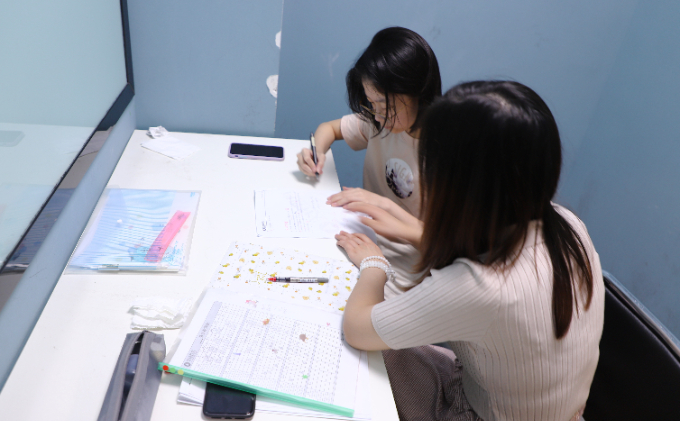


时间: 2023-11-08
来源: 尖锋教育
浏览量: 1773
时态是英语学习中一个至关重要的内容,大家在实际运用英语时,往往对时态倍感棘手,下面小编就归纳复习一下这几种时态。
#英语八种时态#
①一般现在时
概念:经常、反复发生的动作或行为及现在的某种状况。
时间状语:always,usually,often,sometimes,every week(day,year,month…),once a week,on Sundays,etc.
基本结构:①be动词;②行为动词
否定形式:①am/is/are+not;②此时态的谓语动词若为行为动词,则在其前加don't,如主语为第三人称单数,则用doesn't,同时还原行为动词。
一般疑问句:①把be动词放于句首;②用助动词do提问,如主语为第三人称单数,则用does,同时,还原行为动词。
②一般过去时
概念:过去某个时间里发生的动作或状态;过去习惯性、经常性的动作、行为。
时间状语:ago,yesterday,the day before yesterday,last week(year,night,month…),in 1989,just now,at the age of 5,one day,long long ago,once upon a time,etc.
基本结构:①be动词;②行为动词
否定形式:①was/were+not;②在行为动词前加didn't,同时还原行为动词。
一般疑问句:①was或were放于句首;②用助动词do的过去式did提问,同时还原行为动词。
③现在进行时
概念:表示现阶段或说话时正在进行的动作及行为。
时间状语:now,at this time,these days,etc.
基本结构:am/is/are+doing
否定形式:am/is/are+not+doing.
一般疑问句:把be动词放于句首。
④过去进行时
概念:表示过去某段时间或某一时刻正在发生或进行的行为或动作。
时间状语:at this time yesterday,at that time或以when引导的谓语动词是一般过去时的时间状语等。
基本结构:was/were+doing
否定形式:was/were+not+doing.
一般疑问句:把was或were放于句首。
⑤现在完成时
概念:过去发生或已经完成的动作对现在造成的影响或结果,或从过去已经开始,持续到现在的动作或状态。
时间状语:recently,lately,since…for…,in the past few years,etc.
基本结构:have/has+done
否定形式:have/has+not+d one.
一般疑问句:have或has。
⑥过去完成时
概念:以过去某个时间为标准,在此以前发生的动作或行为,或在过去某动作之前完成的行为,即“过去的过去”。
时间状语:before,by the end of last year(term,month…),etc.
基本结构:had+done.
否定形式:had+not+done.
一般疑问句:had放于句首。
⑦一般将来时
概念:表示将要发生的动作或存在的状态及打算、计划或准备做某事。
时间状语:tomorrow,next day(week,month,year…),soon,in a few minutes,by…,the day after tomorrow,etc.
基本结构:①am/is/are/going to+do;②will/shall+do.
否定形式:①was/were+not;②在行为动词前加didn't,同时还原行为动词。
一般疑问句:①be放于句首;②will/shall提到句首。
⑧过去将来时
概念:立足于过去某一时刻,从过去看将来,常用于宾语从句中。
时间状语:
the next day(morning,year…),the following month(week…),etc.
基本结构:①was/were/going to+do;②would/should+do.
否定形式:①was/were/not+going to+do;②would/should+not+do.
一般疑问句:①was或were放于句首;②would/should提到句首。
上一篇: 武汉江岸区初中数学一对一辅导机构哪家好
最新文章

在选择培训机构时,由于培训机构数量比较多,不同培训机构在教学能力方面不同,一定要谨慎选择,才能通过培训让自己成绩提升更快。如果你准备在江汉区选择,在选择前要了解一下江汉区培训机构哪家口碑更好?以及选择前还需要试听课吗? 1、江汉区培训机构哪家口碑更好? 在江汉区针对不同年龄段学生培训机构不止一家,每家在教学能力方面,在课程制定方面,在学习环境方面,在收费方面都体现出了自己优势。不过在多家培训机构当中,要说哪家相对口碑更好,尖锋教育就属于在江汉区,包括在国内排名比较靠前的一家,也属于口碑比较好的一家。尤其是在师资力量相对更雄厚,老师都来自于985,211这样名校,由于老师能力强,加上责任心强,经验丰富,能让选择学生把成绩提升很快。 2、选择培训机构前需要先试听课吗? 不管是选择尖锋教育,还是选择其他培训机构,在选择之前都要进行试听课,试听课的目的就是通过试听课,老师教学能力,看是否符...

在学习成绩“内卷”严重的情况下,为了能让孩子的学习成绩落后,家长们也纷纷通过给孩子报名补习机构,以让其学习到更多的知识。但是,吴家山补课的地方哪家机构值得选择呢?接下来我们就一起了解下。 吴家山补课的地方有很多,但不同的补习机构,对于孩子学习成绩的帮助大有不同,比如:当教师团队实力比较强,教学经验比较丰富的时候,就可以通过个性化的教学提升孩子的学习兴趣,帮助他们提高学习效率;当学习方法正确时,也可以提高学习成绩。因此,在选择吴家山补课机构时,可以了解以下几个方面: 1.教师团队:教师团队是补课机构的核心竞争力。一个优秀的教师团队,能够深入了解学生的学习情况,为他们量身定制学习计划,提升学习兴趣,提高学习效率。 2.口碑和服务:补课机构的口碑和服务质量,也是家长们需要考虑的重要因素。一个好的补课机构,应该拥有良好的口碑和优质的服务。他们应该能够为学生提供全面的学习支持,包括学习计划制...

汉阳钟家村,是武汉的一个重要区域,这里不仅汇聚了各式各样的商业设施,也有许多优质的培训机构。然而,对于那些想要提升自己或者为孩子寻找教育资源的家长们来讲,汉阳钟家村培训机构怎么选择就成了大问题。接下来就了解一下教育机构的选择方法。 1.了解机构的口碑 在汉阳钟家村培训机构的时候,了解机构的口碑是重中之重。可以通过网络搜索、社交媒体、论坛等多种渠道了解其他家长和学生的评价。要是大家普遍反映教学质量好、老师负责任、学习环境舒适,那这家机构肯定值得考虑。 2.了解机构的师资力量 要知道老师可是教学的灵魂,优秀的老师不仅具备扎实的学科知识,还能灵活运用各种教学方法,激发学生的学习兴趣。因此,在选择汉阳钟家村培训机构的时候,一定要了解一下它的教师团队,看看他们是不是都具备相关的专业背景和丰富的教学经验。 3.了解机构的课程设置 不同的培训机构有不同的课程设置,建议大家根据自己和孩子的需...

数学培优机构不仅可以帮助学生提高自己校内的数学成绩,也可以帮助学生提升自己的逻辑思维能力。很多家长在学生低年级的时候,就帮助他们找到好的数学培优机构,为的是让孩子从小培养思维能力。青山区数学培优哪里好?怎样可以找到更好的数学培优机构?这三个选择方法可以了解一下。 1.找行业内的优秀教师 数学培优机构的选择,更多的是找到好的任课教师。数学逻辑思维的培养是需要很专业的老师授课的,所以家长应该找这个领域内有名的教师,为自己的孩子提供课程的辅导。选择数学培优机构的时候,也需要先了解清楚任课教师的信息,找到知名度高的教师,给孩子提供课程辅导。 2.找教学经验丰富的机构 青山区数学培优哪里好?找数学培优机构的时候,也需要选择教学经验丰富的培优机构,他们有自己成熟的教育体系,对于数学培优内容也有自己的见解,可以帮助不同的学生制定好教学计划,对于学生来说也是很有收益的。 3.找知名度高的机构 ...

好的培训班是可以帮助学生提高自己的文化课成绩,从学生现阶段的学习情况出发,制定更有效的学习计划,这也是家长花费时间帮助孩子挑选优质的培训班的目的。白沙洲附近的培训班哪个好?家长们在选择培训班之前,可以先看看这篇文章介绍的三个选择培训班的技巧,让自己找到的培训班更专业。 1.选口碑好的培训班 培训班好不好,是可以通过这里的口碑了解的。一个培训班可以拥有好的口碑,一定是得到了家长和学生认可的,因为学生们可以通过培训班的帮助,提高自己的文化课成绩。所以选择白沙洲附近的培训班的时候,可以先筛选出口碑好的培训班,缩小选择的范围,提升培训班的选择速度。 2.选教学质量好的培训班 找白沙洲附近的培训班的时候,也需要找到教学质量好的培训班,这也是保证学生有好的学习效果的基本要求。培训班需要有专业的教师,为学生们提供课程的教学服务,同时还需要有专业的学习管理师,密切关注学生的学习状态,及时与家长...

学生之所以选择补课,往往是自己成绩跟不上,一旦学生成绩跟不上,特别是小学,中学,就会导致以后课程无法进行,会导致学生出现厌学。如果你想选择补课,接下来为你分享一下盘龙城哪里补课好?以及学生补课能达到想要效果吗。 盘龙城哪里补课机构好 有关盘龙城哪里补课好?在选择补课机构时主要是看补课机构口碑,凡是口碑比较好的,就证明教学能力比较强,老师责任心强,都是通过严格筛选才可以进行上岗对学生进行补课。当然还要看学习环境,以及是否能线上线下都可以进行补课,这样可以满足不同学生进行补课。还有就是在收费方面,收费合理,能让选择学生少花钱,也可以通过补课能掌握更多知识。比如目前要说在盘龙城区域哪里补课比较好?不管是小学,中学,高中,通过对比,愿意选择尖锋教育的比较多。 学生补课能达到想要效果吗? 学生在进行补课时,是否能达到想要效果,这个要看选择补课机构,补课机构如果老师责任心强,能根据学生...
在线咨询
电话咨询
17771439616